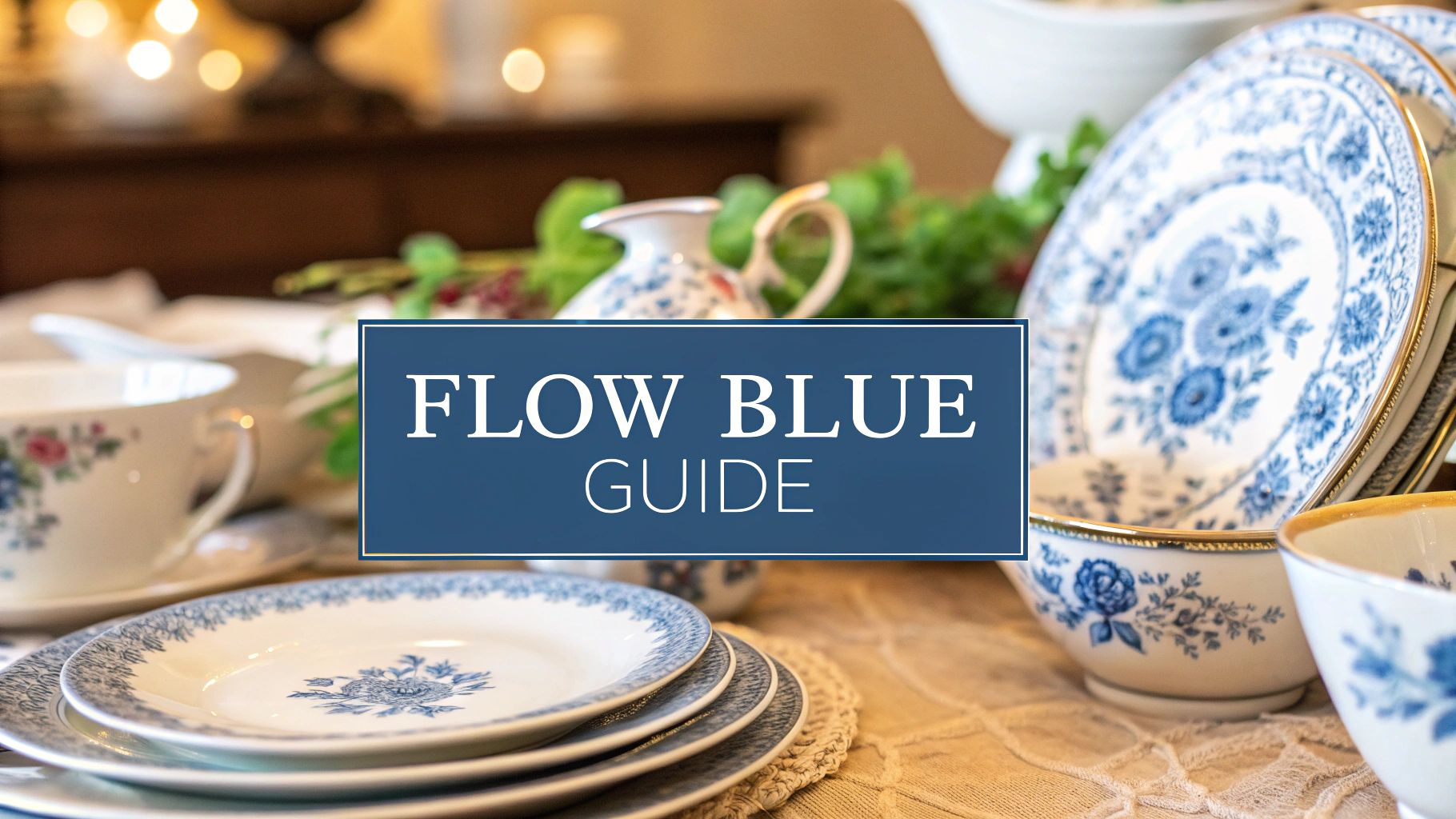You can spot Flow Blue dinnerware from a mile away. It’s famous for that signature blurred, hazy cobalt blue pattern that looks almost like a watercolor painting. This wasn't an intentional design at first; it happened when a chemical added during the firing process made the blue pigment "flow" into the white glaze, creating a soft, bleeding effect.
The Story of an Accidental Masterpiece
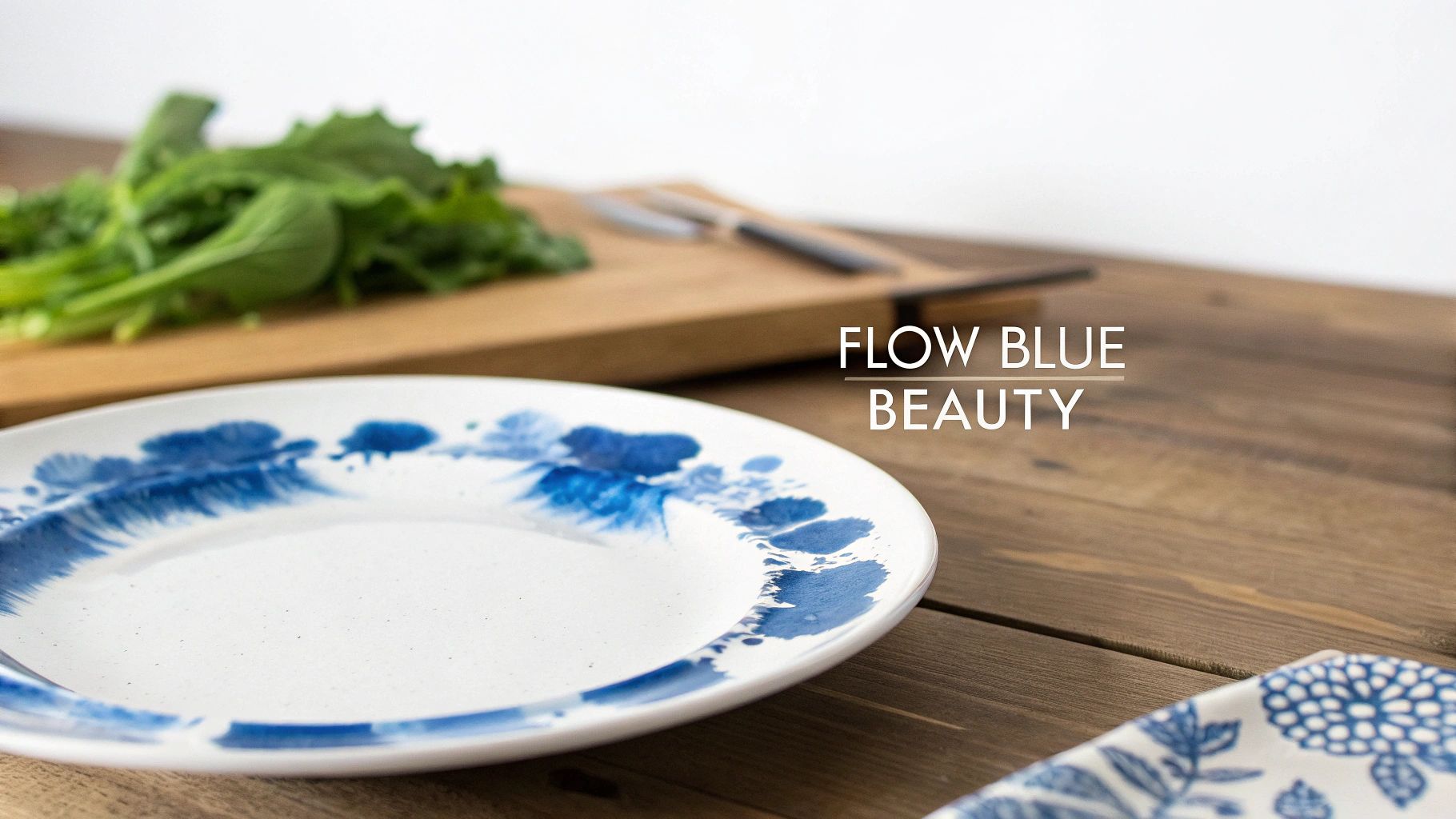
Think about a watercolor painting where the deep blue ink softly bleeds into a crisp white background, creating a dreamy, almost ethereal look. That’s the magic of Flow Blue dinnerware, a style that was born from a happy accident in the potteries of 19th-century England. It wasn't some deliberate artistic choice—it was a beautiful flaw that ended up charming the world.
A Flaw Becomes Fashion
Our story starts in Staffordshire, England, around the 1820s. English potters were in a fierce race to compete with the incredibly detailed and expensive hand-painted porcelain coming in from China. They needed to find a way to make elegant-looking dishes that could be mass-produced and sold at a price regular people could afford.
During their experiments, they found that adding a volatile chemical, like lime or ammonia chloride, into the kiln during firing would cause the cobalt blue designs to smudge and bleed. What began as a production mistake quickly turned into a celebrated style. The soft, blurry finish gave the dinnerware a unique charm that was impossible to replicate exactly, which meant no two pieces were ever identical. This "imperfect" look caught on fast.
The real appeal of Flow Blue was that it made beauty accessible. It brought the rich look of cobalt blue, once a luxury for the wealthy, to the growing middle class. Suddenly, families could set a table that felt both sophisticated and inviting.
More Than Just a Pretty Plate
The success of flow blue dinnerware was about more than just its good looks. It marked a huge shift in home life and what it meant to have status. For the very first time, families who weren't rich could afford to own a full, matching set of beautifully patterned dishes. This made Flow Blue a fixture in homes all across Victorian England and, eventually, the United States.
The production process itself is what gave the pieces their distinct character. It involved a few key steps:
- Transferware Printing: Potters would engrave intricate patterns onto copper plates. These designs were often inspired by Asian motifs, romantic countrysides, or elaborate floral arrangements.
- Cobalt Oxide Ink: This special ink was printed onto tissue paper and then carefully applied to the unfired ceramic.
- The Firing Process: Finally, the piece went into the kiln. The introduction of that chemical agent is what caused the signature "flow" we love.
This clever process made it possible to produce complex designs on a massive scale. As we get further into it, you'll see how this beautiful mistake grew into a treasured collectible, valued for both its rich history and timeless appeal.
The Story Behind Flow Blue Pottery
To really get what makes Flow Blue so special, you have to picture Staffordshire, England, back in the 1820s. This wasn't just any town; it was the beating heart of Britain's pottery world, a landscape humming with the heat of kilns and the energy of artisans. The big challenge of the day? Competing with the stunning, hand-painted porcelain coming all the way from China.
English potters were on a mission. They wanted to capture that same delicate beauty but make it affordable enough for the average family. Hand-painting every single plate was out of the question—it was just too slow and expensive. They needed a new way to create beautiful, intricate designs for the masses, and that quest led them to a brilliant accident.
They discovered that if they added a chemical agent, like lime or ammonia chloride, into the kiln during firing, something magical happened. The cobalt blue ink used for the patterns would vaporize just enough to bleed, or "flow," into the white glaze. The result was that iconic soft, slightly blurred, and dreamy effect that we now call Flow Blue.
From English Potteries to American Tables
Back in Victorian England, this new style was a runaway hit. It had the classic, expensive look of blue and white porcelain, but at a price the growing middle class could actually afford. Suddenly, families could own a full set of matching dinnerware that made every meal feel a little more elegant.
Its popularity wasn't confined to England for long. Flow Blue made its way across the Atlantic and, by the mid-to-late 1800s, had become a fixture in American homes. It was a symbol of good taste, a touch of European sophistication right on the dinner table. The romantic, pastoral scenes often featured on the pieces really struck a chord with the American public.
The rise of Flow Blue wasn't just about aesthetics; it was a story of social change. It represented a democratization of style, where beautiful objects were no longer the exclusive property of the aristocracy.
The demand was enormous. Historians estimate that between the mid-1800s and the early 1940s, potteries in England, the United States, and Europe created over 1,500 different patterns. If you're curious about this vast catalog, The Wise Collector's site is a great resource for exploring patterns and their histories. This incredible output shows just how deeply people fell in love with this style.
The Makers Behind the Magic
A handful of potteries became legends in the world of Flow Blue, and their maker's marks are what collectors hunt for today. These companies weren't just stamping out dishes; they were creating art that would last for generations. Some of the biggest names include:
- Wedgwood: A powerhouse in English pottery, their Flow Blue pieces were known for incredible quality and finely detailed patterns.
- Johnson Brothers: Famous for their tough "semi-porcelain," they helped bring Flow Blue to an even wider audience with beloved patterns like 'Georgia'.
- W.H. Grindley: Another Staffordshire giant, Grindley produced a huge variety of Flow Blue patterns that were especially popular in the American market.
- New Wharf Pottery: This pottery was celebrated for its deep, rich cobalt hues and stunning designs inspired by the Far East.
These companies, and many others, harnessed the power of the Industrial Revolution. They paired the new Flow Blue technique with transfer printing, allowing them to produce intricate designs at a scale never seen before. What started as a happy accident in a fiery kiln became a cherished heirloom, passed down through families and admired for its timeless, hazy beauty.
How to Identify Authentic Flow Blue Pieces
Stepping into the world of antique hunting can feel a little intimidating, especially with so many reproductions out there. But when it comes to flow blue dinnerware, you don't need a secret decoder ring to spot the real deal. It’s all about training your eye—and your hands—to pick up on the specific details that separate a Victorian treasure from a modern knock-off.
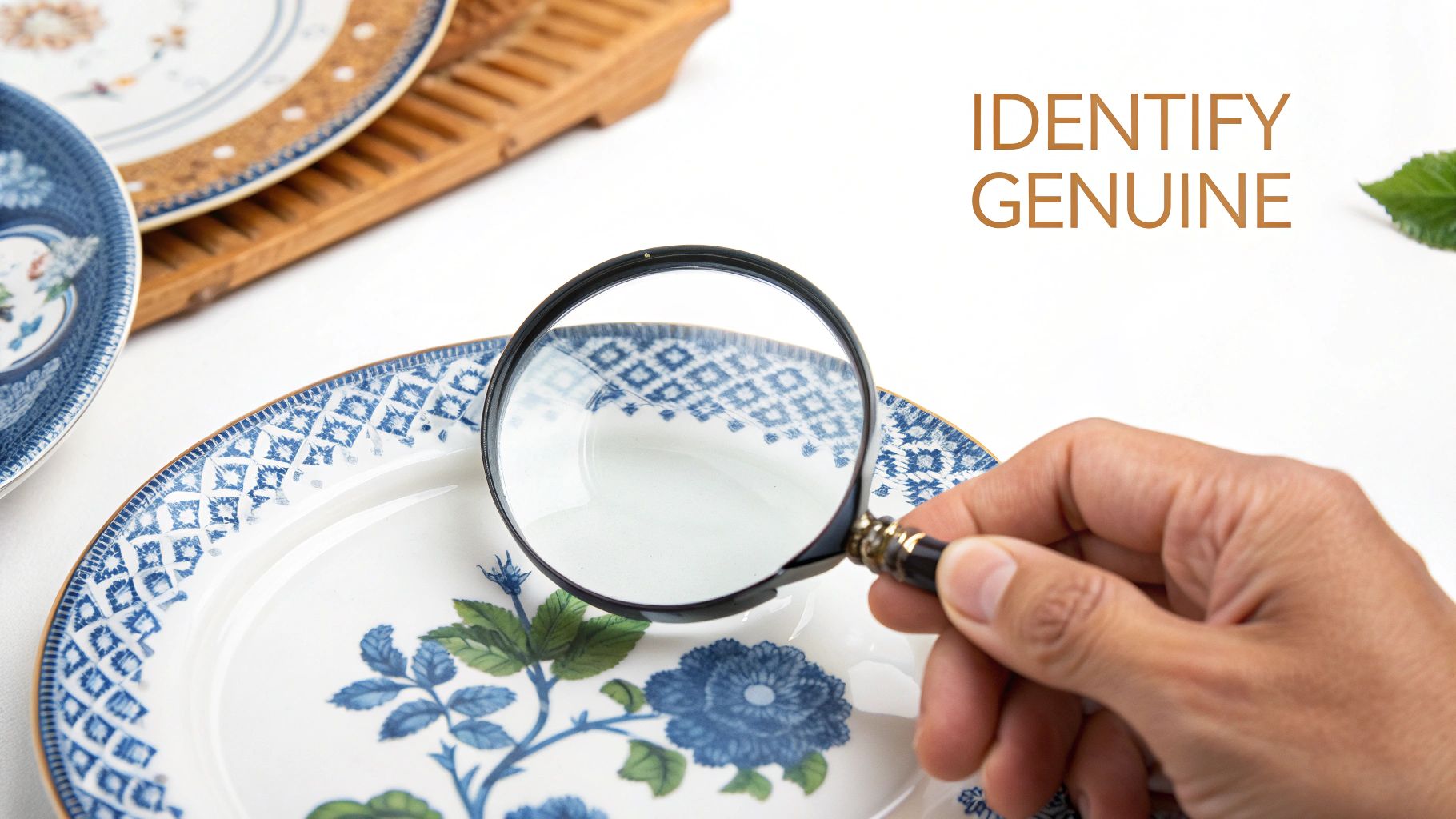
The first thing to look for is right in the name: the "flow." On a genuine piece, the rich cobalt blue pattern will have a soft, hazy bleed into the white ceramic around it. Think of it like watercolor paint bleeding on damp paper. This blurring should look organic and a little uneven—it’s the beautiful, accidental result of a 19th-century firing process.
Modern reproductions just can't seem to get this right. Their blurred effects often look too perfect, too uniform, almost like a digital filter was applied. If the "flow" looks machine-made, trust your gut. It probably is.
Feel the History: Body and Weight
Look beyond the pattern and really get a feel for the piece itself. Pick it up. Antique flow blue was usually made from ironstone or semi-porcelain, and these materials have a satisfying heft. They feel solid and substantial, a clue to their intended use as durable, everyday tableware.
If a piece feels surprisingly light or has a chalky texture, that’s a potential red flag. Early ironstone has a distinct, almost cool touch and a weight that most modern ceramics just don't have. You're not just holding a plate; you're feeling the sturdiness of a bygone era.
The true magic is in the details. An authentic piece of Flow Blue feels like a small story captured in ceramic—from the maker's mark on the bottom to the subtle imperfections that prove it was made by human hands, not a machine.
Another sign of age is crazing—a fine, web-like network of cracks in the glaze. This is a natural part of the aging process for old ceramics. While heavy crazing can sometimes lower the value, its presence is often a good indicator that you're looking at a genuinely old piece.
Deciphering Patterns and Maker's Marks
With over 1,500 documented designs created during its heyday, the world of Flow Blue patterns is a collector's dream. Most of these intricate designs fall into a few popular categories, and recognizing them can help you instantly place a piece in its historical context.
Common pattern themes include:
- Oriental Scenes: Inspired by the Chinese porcelain that English potters were trying to imitate, these often feature pagodas, weeping willows, and delicate bridges.
- Romantic & Pastoral: Think idyllic country landscapes, grand castles, and charming floral arrangements that perfectly captured Victorian sensibilities.
- Floral & Botanical: These were incredibly popular. Intricate patterns of flowers, leaves, and vines, like the famous "Touraine" and "Argyle" designs, are true classics.
The most definitive clue, however, is almost always hiding on the bottom. The maker's mark or backstamp is the potter's signature. It tells you who made it, and sometimes even gives you the pattern name and a rough date. These marks changed over time, so a little detective work can help you pinpoint a piece's age with surprising accuracy.
To help you get started, here's a quick cheat sheet for what to look for when you're examining a potential piece.
Key Characteristics for Identifying Flow Blue
| Characteristic | What to Look For | Pro Tip |
|---|---|---|
| The "Flow" | A soft, hazy, and slightly irregular bleed of the cobalt blue pattern into the white ceramic. | Avoid pieces where the blur looks too perfect or digitally printed. True flow is organic. |
| Weight & Feel | The piece should feel heavy and substantial for its size. The material (ironstone) often feels cool to the touch. | If it feels light, thin, or chalky, it might be a modern reproduction. |
| Glaze | Look for fine, web-like cracks in the glaze, known as crazing. This is a natural sign of age. | The absence of crazing isn't a deal-breaker, but its presence is a strong clue of authenticity. |
| Maker's Mark | Check the bottom for a backstamp—a logo, name, or symbol identifying the pottery. | Use a guide to match the mark to a specific maker and date range. A clear mark greatly increases value. |
Learning to read these backstamps is a game-changer for any collector. If you're ready to go deeper, our comprehensive pottery marks identification guide is an excellent place to start.
Famous potteries like W.H. Grindley, Johnson Brothers, and Wedgwood all used distinctive marks—a crown, a globe, or an intricate crest. By comparing the mark on your find to a reliable guide, you can confirm its authenticity and connect it to a specific maker and era. That little stamp is what turns a pretty plate into a verifiable piece of history.
How to Value Your Flow Blue Collection
Figuring out the value of Flow Blue dinnerware can feel a bit like playing detective. For any collector, it always boils down to two big questions: "How old is it?" and "What's it worth?" The good news is, you don't need to be a professional appraiser to get a solid idea of what your collection is worth. A piece's price is shaped by a handful of clear factors, from its size and rarity to the quality of that famous blue blur.
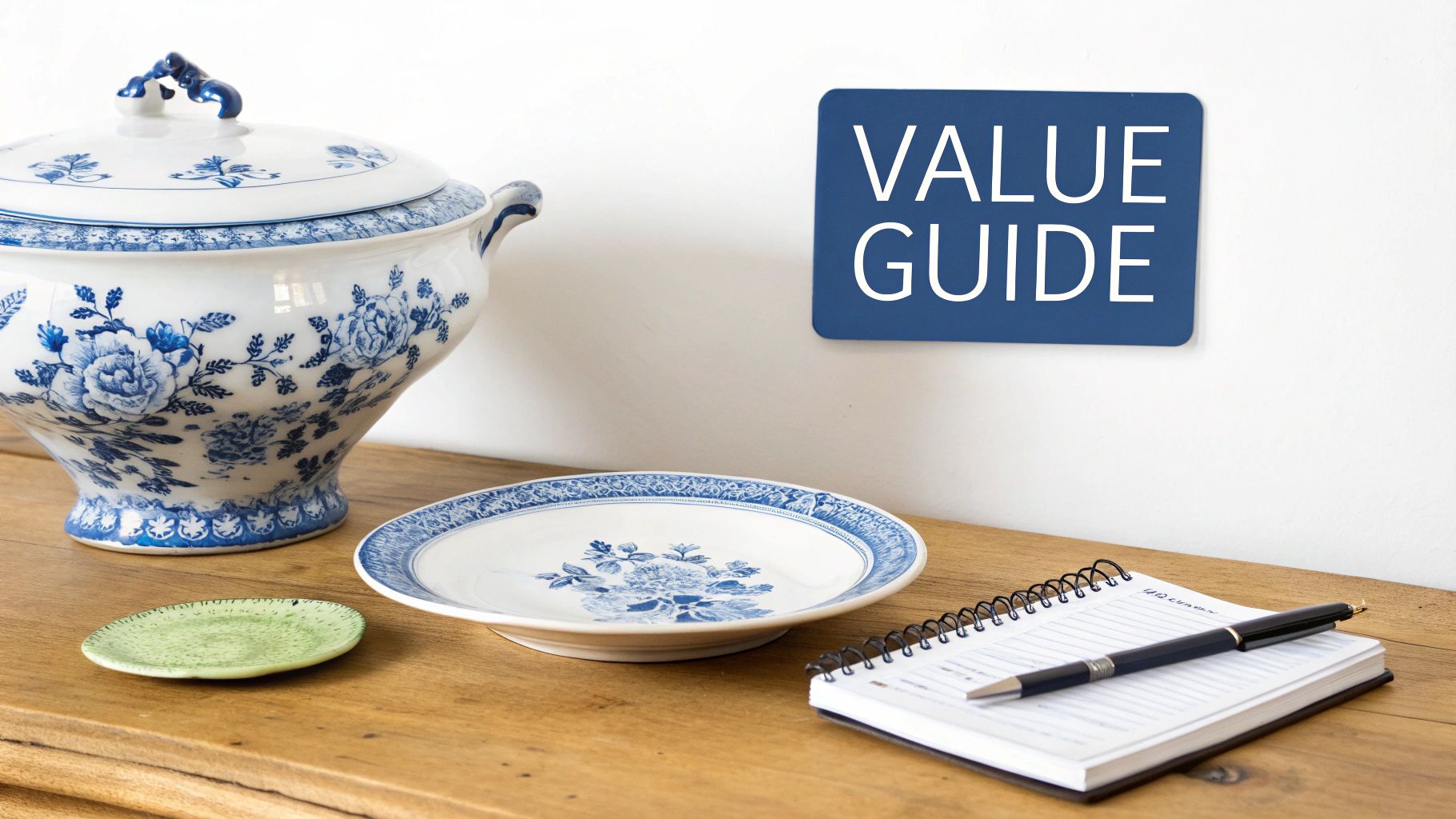
Getting a handle on these key elements won't just help you appraise the treasures you already have—it'll make you a much smarter buyer. It’s all about learning what to look for, so you can spot an undervalued gem or avoid overpaying for a piece with hidden flaws. Let's break down what really drives the value up or down.
Rarity and Form
One of the biggest pieces of the puzzle is rarity. A common dinner plate in a popular pattern like 'Touraine' might be relatively easy to find and afford. But a matching gravy boat, covered tureen, or teapot from that very same set? That could be worth hundreds, maybe even thousands, of dollars.
Why the huge difference? Potteries simply made fewer of these larger, more unusual forms. On top of that, these were the pieces most likely to get broken over the years. Think of it this way: for every ten dinner plates a factory produced, they might have only made one soup tureen. Fast forward 150 years, and most of those tureens are long gone. The few that are left are true survivors, and that scarcity sends their value soaring.
Assessing the Quality of the Flow
Not all "flow" is created equal. The very thing that gives this china its name is also a huge factor in what it's worth. Collectors and dealers often group pieces by how intense the blur is, which has a direct impact on both desirability and price.
- Subtle Flow: This is a light, hazy effect where the pattern is still quite clear. You often see this in earlier pieces, and it has a delicate charm that some collectors love.
- Medium Flow: This is the look most people picture—a noticeable bleed that softens the pattern's edges without completely hiding the design. For many, this is the sweet spot.
- Heavy or Inky Flow: This is where the cobalt has bled so much that the pattern becomes a deep, dreamy blur, sometimes almost to the point of abstraction. These dramatic pieces are prized for their bold, painterly quality.
In most cases, a nice, balanced medium flow or a rich, inky one will fetch a higher price than a very faint one. What you're really looking for is a visually stunning effect that makes the pattern even more beautiful.
Condition Is King
No matter how rare or old a piece is, its condition is everything. Damage can slash the value, so you have to inspect every item with a critical eye. The key is learning to tell the difference between acceptable signs of age and serious, value-killing flaws.
A common mistake is thinking that old china should be perfect. The truth is, signs of use are part of an antique's story. The trick is knowing a minor imperfection from a major defect that tanks the item's value.
Here’s what to look for when you're giving a piece a once-over:
- Chips and Cracks: Even a tiny chip on the rim or a hairline crack can cut a piece's value by 50% or more. A great tip is to hold the item up to a bright light; it will make faint cracks much easier to spot.
- Crazing: This is that fine web of tiny cracks you see in the glaze. If it's light and clean, it's just a natural part of aging and usually fine. But heavy crazing, especially if it's dark and stained, will definitely lower the value.
- Repairs: Be on the lookout for old repairs. You might see mismatched glaze, leftover glue, or spots that feel rough. A professional restoration is one thing, but a bad amateur fix is a major red flag. An unrepaired piece in great shape is always the most valuable.
Learning to spot these things takes practice, but it's the most important skill you can develop as a collector. For a wider look at how these principles work, this helpful price guide to antique furniture and other items shows how condition and rarity affect value across all kinds of collectibles. At the end of the day, the perfect find is a piece that's rare, in amazing condition, and has that beautiful, sought-after flow.
Caring For and Displaying Your Collection
Your flow blue dinnerware isn't just a set of pretty dishes; these pieces are genuine links to the past. Keeping them beautiful for generations to come requires a gentle touch and some thoughtful care. It all starts with how you handle them day-to-day.
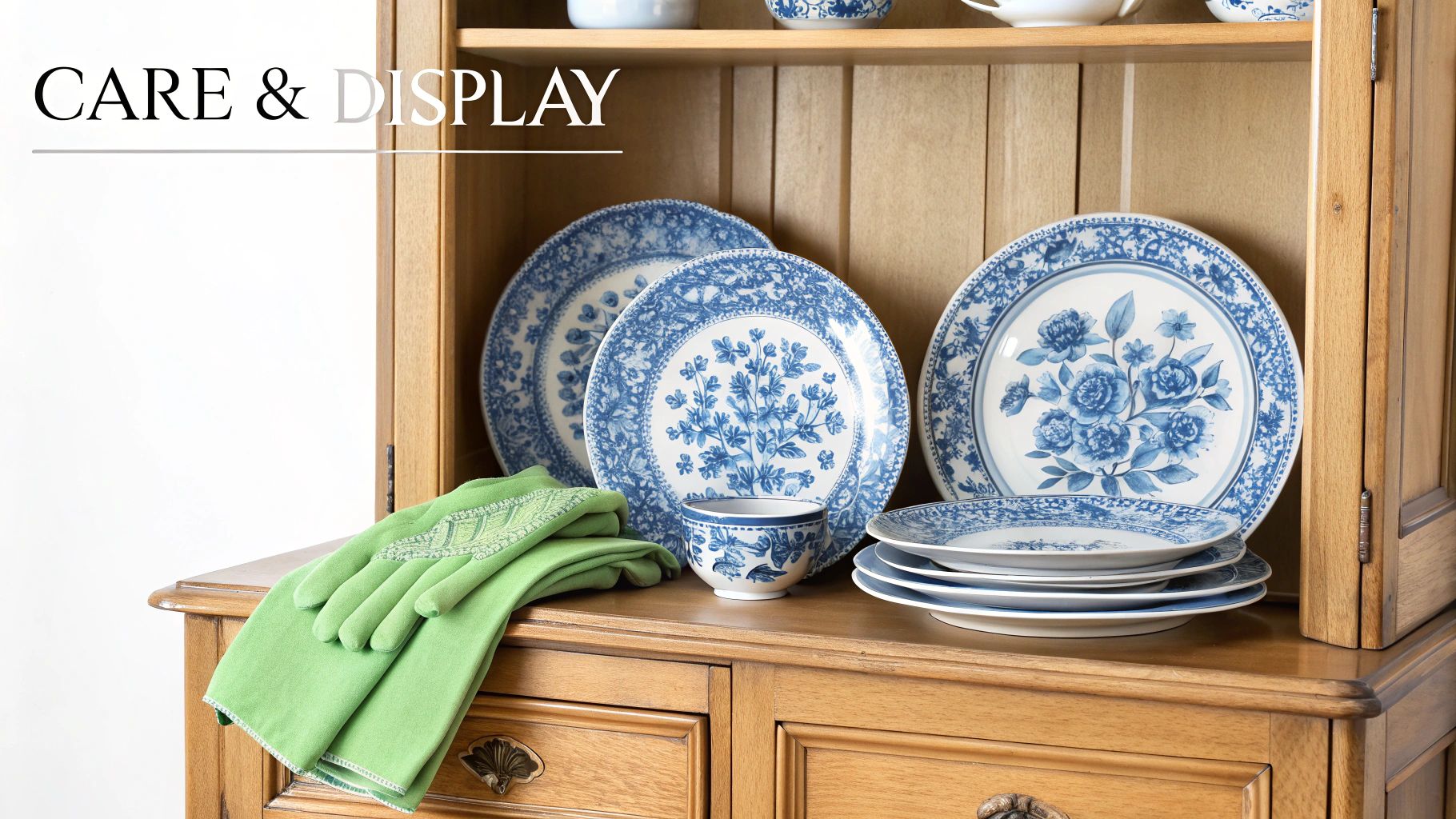
If you take away only one piece of advice, let it be this: never put antique ceramics in the dishwasher. It's a recipe for disaster. The combination of intense heat, harsh detergents, and powerful water jets can cause damage you can't undo. High temperatures can make existing crazing worse, and abrasive soaps will quickly dull a glaze that has shone for over a century.
The right way is the old-fashioned way. Wash each piece by hand, one at a time, in a plastic basin or a sink lined with a soft towel to prevent accidental chips. Use lukewarm water with just a tiny bit of mild, non-citrus soap. A soft cloth is all you need—stay far away from scrubby sponges or brushes that can easily scratch the surface.
Smart Storage and Preservation
How you store your Flow Blue is just as important as how you clean it. Your main goal is to prevent the usual culprits of damage: chips, cracks, and fading. Stacking plates directly on top of each other is probably the number one cause of scratches and tiny rim chips.
A simple fix is to place a soft buffer between each piece. You can get felt plate separators, but acid-free paper or even a basic paper towel works just as well. And for cups, please don't hang them by their handles! This puts constant stress on the weakest point of the piece. It's much safer to store them sitting upright on a sturdy shelf.
Expert Tip: Your collection's worst enemies are drastic temperature changes and direct sunlight. Keep your pieces away from sunny windows, heat vents, and damp basements to stop the colors from fading and prevent more crazing in the glaze.
What if a piece is already broken? For anything beyond a tiny chip, it's best to call in a professional. A skilled ceramic restorer can work wonders, making repairs that are nearly invisible and, more importantly, stabilize the piece. Trying to fix it yourself with superglue often causes more problems and can make a future professional restoration much more difficult and expensive.
Turning Your Collection Into Decor
Preserving your collection is essential, but the real fun is in the display. These beautiful pieces shouldn't be locked away in a closet. They deserve to be part of your home's decor, where you can see and appreciate their history every day. A classic glass-front hutch is a fantastic way to show off a full set.
If you're after a more contemporary look, try creating a gallery wall with a group of plates. Arrange them in a pattern you find pleasing on a large wall, and use secure, spring-loaded plate hangers to make sure they're mounted safely. This approach transforms a few individual plates into a stunning, large-scale piece of art.
The rich cobalt and white patterns of Flow Blue fit beautifully within certain aesthetics. For instance, they feel right at home with the classic, traditional look of Colonial Revival interior design, which provides a perfect backdrop. If you need more inspiration, our full guide on creative collectible display ideas has plenty of tips to help you showcase your treasures safely and stylishly.
Why We Still Can’t Get Enough of Flow Blue
So, what’s the secret? What gives Flow Blue dinnerware its staying power, almost 200 years after it first appeared? It’s not just one thing, but a magical combination of accidental artistry, rich history, and a look that somehow never goes out of style.
That soft, hazy effect—the "flow"—gives each piece a dreamy quality you just don't find in modern, mass-produced dishes. It’s perfectly imperfect.
Every plate and platter tells a story of innovation, born from a happy accident in a Staffordshire pottery kiln. This wasn't just about creating pretty dishes; it was about making elegance affordable for the growing middle class. Owning a piece of Flow Blue is like holding a direct connection to the Victorian era, a tangible link to the families who used and cherished it generations ago.
A Classic Look That Works Anywhere
Let's face it, blue and white is a color combination that never fails. It’s timeless. This is a huge part of Flow Blue’s charm, as it slides effortlessly into just about any home decor style, from traditional farmhouse to sleek and modern.
Designers and homeowners love using it to add a splash of character and history to a room. Whether you hang a collection of plates on the wall or bring them out for a special dinner, Flow Blue instantly adds soul.
Its lasting popularity is part of a bigger trend.
The global market for ceramic tableware, which includes classic styles just like this, was valued at around USD 2.22 billion back in 2020. Flow Blue is a piece of that puzzle, proving that great design and quality craftsmanship are always in demand. You can dig deeper into the ceramic tableware market at askwonder.com.
More Than Just a Dish
Ultimately, what truly hooks a collector is the personal connection. These aren't just objects; they’re heirlooms. They carry the silent memories of countless family dinners, holiday toasts, and quiet conversations.
A little crazing or a gently worn gold rim isn't damage—it's proof of a life well-lived. It’s the evidence of history.
This blend of visual appeal, historical depth, and personal nostalgia is what keeps collectors searching for that next perfect piece. Flow Blue is a beautiful reminder that sometimes, the most wonderful things are born from a simple mistake.
Answering Your Flow Blue Questions
As you get more into collecting, you'll find certain questions come up over and over. You might be wondering if you can actually serve dinner on those beautiful old plates, or maybe you're worried about accidentally buying a fake.
This is your go-to spot for clear, straightforward answers. Let's tackle some of the most common questions every Flow Blue enthusiast asks at some point.
Is It Safe to Eat From Flow Blue Dinnerware?
This is the big one, and the short answer is: it's best not to. While these dishes were made for the dinner table, safety standards have changed dramatically since the 19th century. The main worry is lead, which was a common ingredient in glazes back then.
On top of that, if a piece has crazing (those tiny cracks in the glaze), there's a risk of bacteria getting trapped in the crevices. The glaze itself could also leach into acidic foods.
Our Recommendation: Play it safe and keep your antique Flow Blue for display. If you absolutely love the look for dining, there are some wonderful modern reproductions made by reputable companies that are certified food-safe.
How Can I Spot a Fake or Reproduction?
Telling a genuine antique from a modern copy is a skill every collector needs. We've gone over the key traits of authentic pieces, but here are a few red flags that should make you pause.
- It Looks Too Perfect: Real Flow Blue has a wonderful, slightly unpredictable bleed. Reproductions often look too uniform, almost like the blurry effect was printed on by a machine.
- It Feels Too Light: Old ironstone has a satisfying heft to it. If you pick up a piece and it feels surprisingly light or thin, it's a good reason to be suspicious.
- The Mark Is Off: A missing or strange-looking backstamp is a major warning sign. Fakes might have a blurry mark, or they might use a maker's logo from the wrong time period for the style of the dish.
Does Crazing Lower the Value?
Crazing—that fine network of cracks in the glaze—is just part of the natural aging process for old ceramics. In fact, a bit of light, clean crazing is often seen as a sign of genuine age and is perfectly acceptable to most collectors.
Where it becomes a problem is when it's severe. Heavy, dark staining that has seeped into the craze lines is considered damage, and that will definitely bring the value down. A piece with no crazing is the ideal find, but don't pass up a great item just because of a little light, even crazing.
Ready to uncover the history and value of your own treasures? The Curio app puts an antique expert in your pocket. Just snap a photo to instantly identify items, get an estimated value, and learn the fascinating stories behind your finds. Download Curio and start your discovery journey today at https://www.curio.app.
